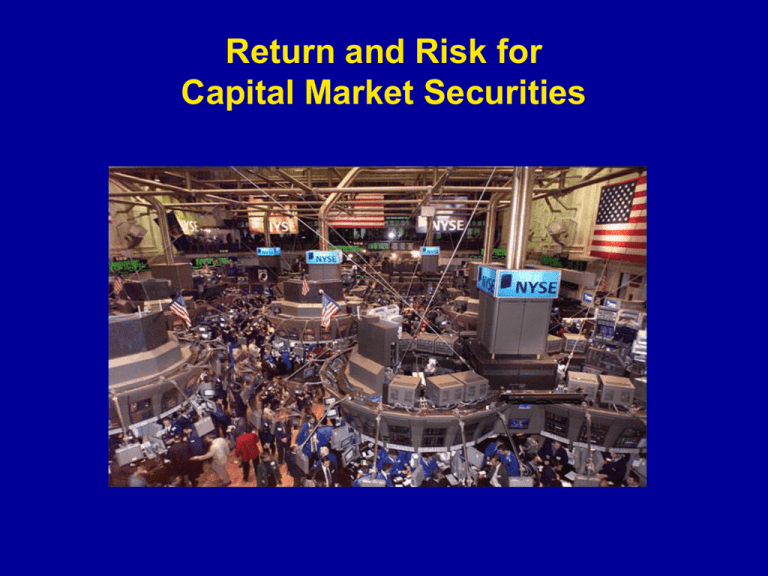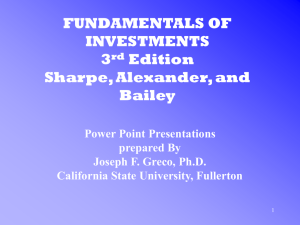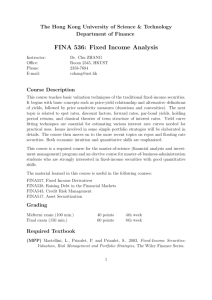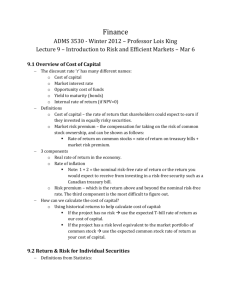Sum of cash distributed plus capital gain
advertisement

Return and Risk for Capital Market Securities Rate of Return Concepts • Dollar return • Number of $ received over a period (one year, say) • Sum of cash distributed plus capital gain (loss) • Percentage return • Dollar return/(beginning-of-period value) • % cash distribution + % capital gain • Real vs. Nominal return • Real % return, r, related to nominal % return, R, by: 1+R = (1+r)(1+h) Standard Deviation as a Measure of Risk 1 T 2 Var ( R) ( R R ) t T 1 t 1 SD( R) Var ( R) • Variance and standard deviation give equal weight to observations above & below mean • These make sense as risk measures if the return distribution is symmetrical Investor Portfolio Choices: Risk and Return • How does holding securities in portfolios affect the risk-return combinations available to investors? • When and why does it pay to diversify across securities? Return Distributions • Expected Return and Standard Deviation for stocks and portfolios with S possible scenarios S E ( R) Rs prob( s) s 1 S var( R) ( R) Rs E ( R) prob( s) 2 2 s 1 stdev( R) ( R) ( R) 2 Portfolio Return and Variance S N s 1 i 1 E ( R p ) R ps prob ( s ) X i E ( Ri ) R ps E ( R p ) prob( s ) S 2 p 2 s 1 • What’s the relationship between portfolio variance and variances of individual securities? Covariance S cov( RA , RB ) RAs E ( RA ) RBs E ( RB ) prob ( s ) s 1 • Covariance measures the extent to which two securities’ returns tend to vary together Correlation AB cov( RA , RB ) A B • Correlation is a “standardized” measure of covariance • AB varies between -1 (perfect negative correlation and +1 (perfect positive correlation) Portfolio Variance and Correlation (2 Securities) X X 2 X A X B cov( RA , RB ) 2 p 2 A 2 A 2 B 2 B X (1 X A ) 2 X A (1 X A ) AB A B 2 p 2 A p 2 A 2 p 2 2 B When Does Diversification Pay? a) Combine two securities with the lowest possible return correlation b) Combine large numbers of identical securities whose returns are less than perfectly correlated a) Diversifying with 2 Securities • With perfect positive correlation, combining securities does not improve the risk-return possibilities (opportunity set) • The lower the correlation, the more the opportunity set improves • With perfect negative correlation, we can eliminate risk altogether b) Diversifying Across Many, Identical Securities p (n 1) 2 n n 2 n p 2 • Diversification can eliminate “unsystematic” risk • Systematic risk stems from the common thread running through all securities’ returns and cannot be diversified away Diversification and the Reward for Risk • Total Risk = Systematic Risk + Unsystematic Risk • Well diversified portfolios should contain almost entirely systematic risk • Investors shouldn’t expect a reward for bearing unsystematic risk, since that can be eliminated (fairly cheaply) through diversification Measuring Systematic Risk • Suppose the return on Security i at time t takes the form: Rit i i RMt t Expected Return “Surprise” Return Measuring Systematic Risk Using Regression • Suppose we regress returns on Security i against the returns on the market portfolio • The regression error term represents it, the “surprise” return component • The slope coefficient, it, represents the extent to which i moves with the market • R2 = % total risk that is systematic (1-R2 = % unsystematic) Properties of Beta • From the properties of linear regression, we can say about beta: cov( Ri , RM ) iM ( Ri ) ( RM ) i 2 ( RM ) 2 ( RM ) iM ( Ri ) M 1 ( RM ) Beta Estimates (Table 11.5) (updated from finance.yahoo.com) Company Beta McGraw-Hill 0.89 MMM 0.82 McDonald’s 1.12 Bed, Bath & Beyond 1.46 Home Depot 1.01 Dell 1.13 eBay 3.90 Computer Associates (CA) 1.86 Portfolio Beta p X i i i • Portfolio beta is the weighted average of the individual security betas • Since M = 1, the average beta of all securities is equal to 1 The Security Market Line • All securities should plot along the same security market line • If they didn’t, investors would shun one security in favor of another E ( RA ) R f A E ( RB ) R f B Capital Asset Pricing Model (CAPM) • Since the market portfolio should also plot along the security market line, for any security i: E ( Ri ) R f i E ( RM ) R f M E ( RM ) R f E ( Ri ) R f i E ( RM ) R f Interpreting CAPM E ( Ri ) R f i E ( RM ) R f Pure time value Reward for bearing systematic risk




